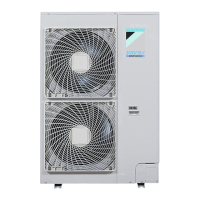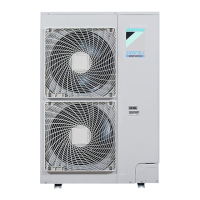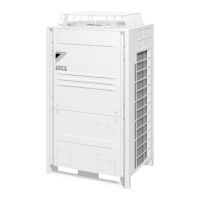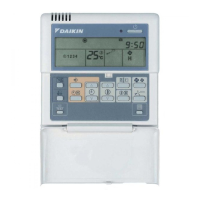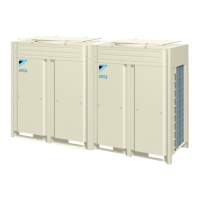Do you have a question about the Daikin REMQ16P8Y1B and is the answer not in the manual?
Details on possible combinations of outdoor units and their total capacity.
Lists standard accessories provided with the outdoor unit, referencing their location.
Lists optional accessories required for installation, such as refrigerant branching kits.
Refers to the Engineering Data Book for detailed technical and electrical specifications.
Provides information on the main components and their functions, referencing the Engineering Data Book.
Guidelines for selecting a suitable installation location for the unit, considering environmental and operational factors.
Procedures for inspecting the unit upon delivery and safe handling practices during transport and installation.
Instructions for unpacking the unit and placing it on a solid foundation, including mounting details.
Specifies tools required for refrigerant piping installation, emphasizing R410A compatibility.
Details on selecting appropriate piping material, temper grade, and thickness for R410A.
Instructions and precautions for connecting refrigerant piping, including nitrogen blow procedures.
Describes front/side connection methods and procedures for removing pinched piping.
Details on connecting refrigerant piping between outdoor units, including patterns and precautions.
Measures to prevent foreign materials and contamination from entering the system during piping installation.
Illustrative examples of refrigerant piping connections for various system configurations.
Guidance on selecting correct pipe sizes for different sections of the refrigerant piping system.
Lists necessary items and preparations before performing leak test and vacuum drying.
Step-by-step procedure for conducting airtightness tests and vacuum drying of the system.
Lists and explains abbreviations for internal wiring components used in the unit.
Information on connecting optional parts and adapters to the unit's connectors.
Specifies power circuit requirements, cable sizes, and safety devices for unit connection.
Important general precautions related to electrical wiring, power supply, and system configuration.
Illustrates typical system configurations and wiring diagrams for power and transmission lines.
Instructions for routing power and transmission lines, including conduit usage and precautions.
Details on connecting transmission wiring between outdoor units, BS units, and indoor units.
Guidelines for connecting the main power wiring to the unit's terminal block and grounding.
Provides a diagram and explanation for internal wiring connections within the unit's electric box.
Instructions for insulating refrigerant piping and connections to prevent condensation and heat loss.
Checklist for verifying correct piping size and insulation installation.
Checklist for verifying correct power and transmission wiring, and insulation resistance.
Key information about R410A refrigerant, GWP, and handling precautions.
Specific precautions for charging R410A, including using correct tools and procedures.
Detailed steps for operating stop valves, including opening and closing procedures and torque specifications.
Method for checking the number of connected indoor and outdoor units using LED indicators.
Guidance on adding refrigerant, including automatic and manual charging procedures.
Steps to input the additional refrigerant charge amount into the PCB after automatic charging.
Safety precautions to follow before performing service on the unit, especially regarding electrical hazards.
A comprehensive checklist of items to verify before the unit's initial start-up.
Instructions for performing field settings using dip switches and push buttons on the PCB.
Procedure for conducting a test operation to check system functionality and identify potential issues.
Final checks to ensure all installation works are completed correctly before normal operation.
Procedure for vacuuming the system, typically required for repair purposes.
Steps for recovering refrigerant using a dedicated reclaimer, following specific operating modes.
Procedures for charging additional refrigerant when automatic methods are insufficient or not required.
Information on calculating and managing the maximum allowable refrigerant concentration in occupied spaces.
Steps to calculate refrigerant concentration and determine necessary actions if levels are exceeded.
Guidelines for the proper dismantling, refrigerant, oil, and parts disposal according to local regulations.
| Brand | Daikin |
|---|---|
| Model | REMQ16P8Y1B |
| Category | Air Conditioner |
| Language | English |


